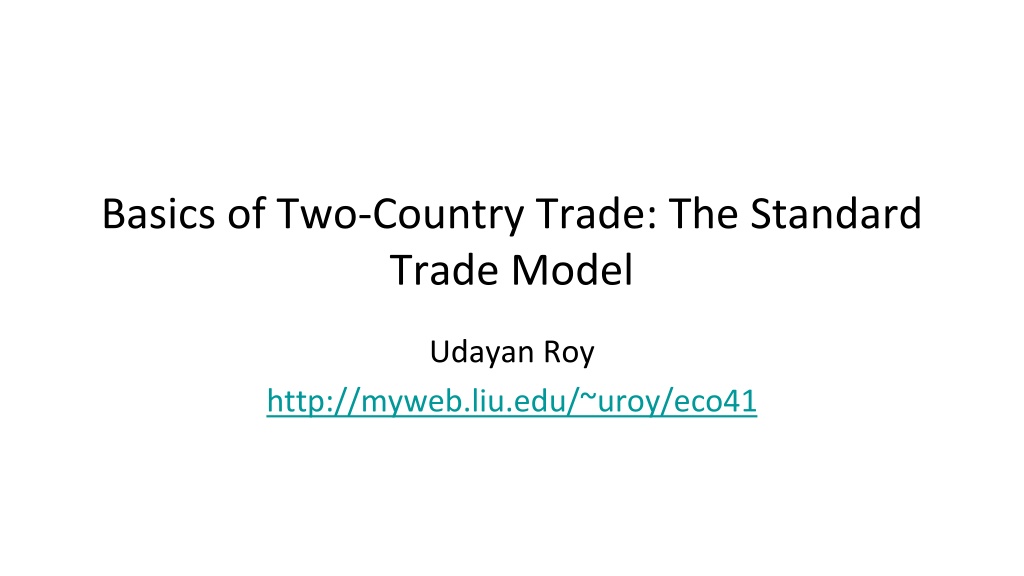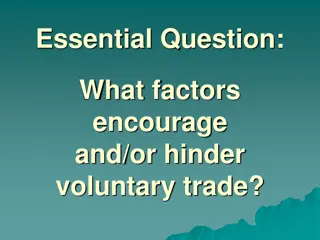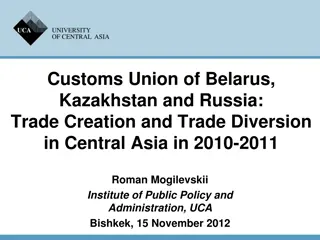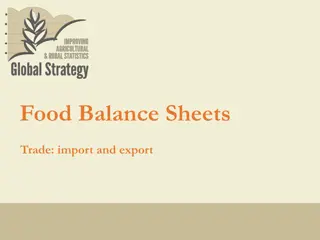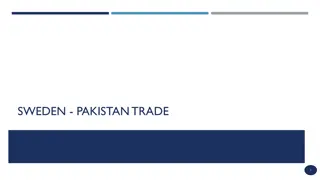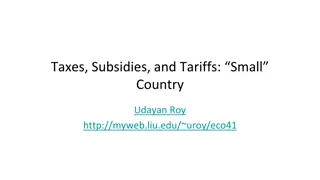Understanding Two-Country Trade Dynamics
Delve into the intricacies of two-country trade using the Standard Trade Model. Explore concepts such as free trade, autarky, balanced trade assumption, and the impact of trading on prices within countries. Gain insight into how international trade influences market values and price equilibrium between nations.
Download Presentation

Please find below an Image/Link to download the presentation.
The content on the website is provided AS IS for your information and personal use only. It may not be sold, licensed, or shared on other websites without obtaining consent from the author. Download presentation by click this link. If you encounter any issues during the download, it is possible that the publisher has removed the file from their server.
E N D
Presentation Transcript
Basics of Two-Country Trade: The Standard Trade Model Udayan Roy http://myweb.liu.edu/~uroy/eco41
Trade Between Two Countries Europe D 0 2 4 6 8 10 12 14 16 18 20 World D 0 2 4 6 8 10 13 16 19 22 25 Trade = S - D J 11 10 9 8 7 6 4 2 0 -2 -4 Japan D 0 0 0 0 0 0 1 2 3 4 5 S 9 8 7 6 5 4 3 2 1 0 0 S 20 18 16 14 12 10 8 6 4 2 1 E 9 6 3 0 -3 -6 -9 -12 -15 -18 -20 Price 10 9 8 7 6 5 4 3 2 1 0 S 11 10 9 8 7 6 5 4 3 2 1 Europe in autarky Free Trade Japan in autarky
Trade Between Two Countries Autarky means no international trade When two countries begin trading The price of any traded good falls where it is expensive in autarky, and rises where it is cheap in autarky Eventually, the price becomes the same in both countries This global free trade price lies somewhere between the two autarky prices
Trade Between Two Countries Under free trade between two countries, any traded good is exported from where it is cheap in autarky to where it is expensive in autarky, and is imported to where it is expensive in autarky from where it is cheap in autarky global quantity demanded = global quantity supplied exports = imports (in quantity and market value)
Trade Between Two Countries Balanced Trade Assumption: A country must pay for its imports of some good (Good X) by exporting an amount of equal market value of some other good (Good Y) In other words, if you import one good you must export another good, and your exports and your imports must be equal in market value
Trade Between Two Countries The previous slides imply that when a country begins trading the price of its imported good falls, and the price of its exported good rises
Prices: nominal and relative So far, I have been not been fully clear about how prices are measured When the price of a good is measured in currency units, it is called a nominal price Example: the nominal price of ice cream is $4.00 per quart Example: the nominal price of coffee is $1.00 per cup
Prices: nominal and relative When the price of one good is measured in units of another good, it is called a relative price Example: suppose the nominal price of ice cream is $4.00 per quart and the nominal price of coffee is $1.00 per cup. Then the relative price of ice cream is 4 cups of coffee per quart. And the relative price of coffee is quarts of ice cream per cup In my lectures on international trade, when I say price I mean relative price
Graphical analysis of two-country trade Now, let us review our numerical analysis using graphs! Economists love graphs!
Europe has the higher autarky price. Europe becomes the importing country. Prices fall. Production falls. This is how the worldwide free trade price is determined. Note that the free trade price ( ) must lie between the two countries autarky prices ( ). Japan has the lower autarky price. Japan becomes the exporting country. Prices rise. Production rises. Note that Japan s exports equal Europe s imports . Price Europe + Japan = World Quantity
Japan: The Exporting Country Price of Steel Domestic supply Price after trade World price Price before trade Domestic demand Exports 0 Quantity of Steel Domestic quantity demanded Domestic quantity supplied
Europe: The Importing Country Price of Steel Domestic supply Price before trade Price after trade World price Domestic demand Imports Quantity of Steel 0 Domestic quantity supplied Domestic quantity demanded
Two-Country Free Trade There are two countries: Home and Foreign Autarky price of wheat is PA in Home and PA* in Foreign So, under free trade, Home will import wheat from Foreign
Supply, Demand, and Trade in a Single Industry In our example, Home imports wheat and Foreign exports wheat Because, in autarky, wheat is expensive in Home and cheap in Foreign: PA > PA* The amount that Home wishes to import will decrease as the price of wheat increases import demand curve; next slide
Supply, Demand, and Trade in a Single Industry Home s import demand curve (MD) is the quantity that Home consumers demand (D) minus the quantity that Home producers supply (S), at each price: MD = D S.
Supply, Demand, and Trade in a Single Industry In our example, Home imports wheat and Foreign exports wheat Because, in autarky, wheat is expensive in Home and cheap in Foreign: PA > PA* The amount that Foreign wishes to export will increase as the price of wheat increases export supply curve; next slide
Supply, Demand, and Trade in a Single Industry Foreign sexport supply curve (XS) is the quantity that Foreign producers supply (S*) minus the quantity that Foreign consumers demand (D*), at each price: XS = S* D*. Note: The Foreign country is indicated by an asterisk (*).
Supply, Demand, and Trade in a Single Industry For equilibrium in free trade between Home and Foreign, we assume: Home s import demand (MD) = Foreign s export supply (XS). Therefore, the equilibrium outcome under free trade between two countries is at the intersection of the import demand and export supply curves See next slide
Figure 9.3 World Free-Trade Equilibrium The equilibrium world price is PW, where Home import demand (MD curve) equals Foreign export supply (XS curve). The amount imported and exported is QW.
Supply, Demand, and Trade in a Single Industry In two-country trade, we assume: Home s import demand (MD) = Foreign s export supply (XS). Therefore, home demand home supply = foreign supply foreign demand. Therefore, home demand + foreign demand = home supply + foreign supply. Therefore, world demand = world supply. Therefore, the equilibrium at the intersection of the import demand and export supply curves is equivalent to the equilibrium at the intersection of the world demand and world supply curves that we saw earlier
Effect of Trade on Prices We have seen that when autarky ends and free trade begins in a country the price of its imported good falls, and the price of its exported good rises How does this affect production and consumption?
Effect of Trade on Production When autarky ends and free trade begins, the production of the exported good increases, and the production of the imported good decreases See the section Production Possibilities and Relative Supply and Figure 5-2 of the course s textbook. As the availability of productive resources is always finite, if a country produces more of something, it must produce less of something else
Effect of Trade on Production When autarky ends and free trade begins, the production of the exported good increases, and the production of the imported good decreases Remember that trade raises the price of the exported good. This gives producers of the exported good an incentive to raise production. Similarly, trade makes the imported good cheaper. This reduces the incentive for domestic producers of the imported good to produce it.
Effect of Trade on Consumption Unfortunately, we can t be sure of the effects of free trade on consumption All we can be sure of is that the consumption of either the imported good or the exported good will surely increase
Effect of Trade on Consumption The effect of an increase in the price of beef (relative to steel) on the consumption of beef works through two channels: Substitution effect: buy less of whatever has become more expensive and more of whatever has become less expensive Income effect: trade has made you richer. So, act the way people act when they get richer: buy more of normal goods and less of inferior goods
Effect of Trade on Consumption Normal goods are goods that people buy more (less) of when they get richer (poorer) Inferior goods are goods that people buy less (more) of when they get richer (poorer) Q: Can you think of examples of normal and inferior goods?
Effect of Trade on Consumption Suppose free trade leads to an increase in the price of beef (relative to steel) Substitution effect: buy less beef and more steel Income effect: Trade has made you richer. So, act like you are richer! Buy more of whichever good is normal Buy less of whichever good is inferior So, the overall effect on beef and steel consumption is uncertain
Effect of Trade on Consumption Suppose free trade leads to a decrease in the price of beef (relative to steel) Substitution effect: buy more beef and less steel Income effect: Trade has made you richer. So, act like you are richer! Buy more of whichever good is normal Buy less of whichever good is inferior So, the overall effect on beef and steel consumption is again uncertain
If the autarky equilibrium price is the same for both countries, no trade will occur even when trade is allowed. That is, similarity = no trade. Price Europe + Japan = World Quantity
Similarity = No Trade If the pre-trade (or autarky) relative prices (of one good in terms of another) are the same for the two countries, no trade will occur. On relative prices, see the section Relative Prices and Supply of the course s textbook.
As we saw before, if the autarky equilibrium price is not the same for both countries, trade will occur when trade is allowed. That is, dissimilarity = trade. Price Europe + Japan = World Quantity
Dissimilarity = Trade Trade will occur if the pre-trade (or autarky) relative price of one good in terms of the other is not the same for the two countries. The free trade relative price will be neither higher than the two autarky prices, nor lower. Therefore, when the autarky relative prices are unequal, the free trade relative price must be different from the autarky relative price for at least one of the two countries.
Reasons For Dissimilarity Three theories that explain why autarky prices may be high in some countries and low in others: Ricardian Theory Specific Factors Theory Heckscher-Ohlin Theory
Opportunity Cost The opportunity cost of good X is the amount of good Y that will have to be sacrificed when an additional unit of X is produced Between two trading countries, one country is said to have a comparative advantage in the production of a good if, in autarky, the opportunity cost of the good is smaller in that country
Opportunity Cost = Autarky Price In a perfectly competitive economy, the opportunity cost of good X equals the autarky relative price of good X. Therefore, between two trading countries, one country is said to have a comparative advantage in the production of a good if the autarky relative price of the good is smaller in that country
Trade Follows Comparative Advantage We have seen that the country with the cheaper autarky price of a good becomes the exporter of that good, and the country with the higher autarky price of a good becomes the importer of that good Therefore, we can say that whichever country has a comparative advantage in the production of a good becomes the exporter of that good
Trade Reflects Comparative Advantage When autarky ends and free trade begins, each country increases its production of the good in which it has a comparative advantage and exports that good. In other words, free trade follows the principle of comparative advantage.
